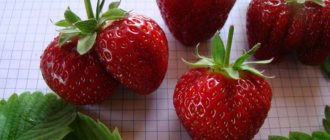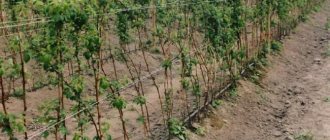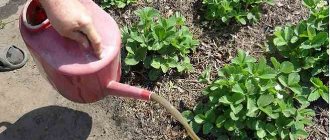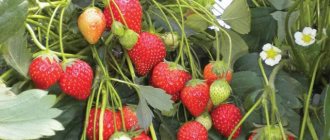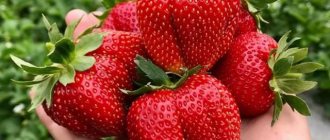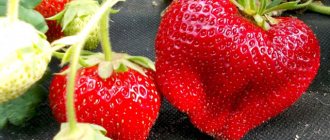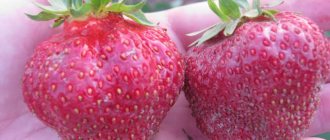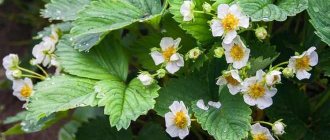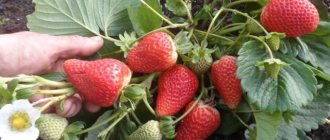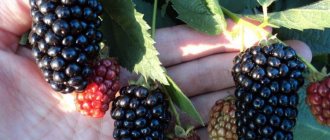Victoria variety: strawberry or wild strawberry?
It is generally accepted that strawberries are grown in fields and gardens, and wild strawberries are wild berries from the forest. Is this really true? In fact, quite a few strawberries in the garden beds are in fact garden strawberries, including the Victoria variety. What's the difference?
Strawberries have small, pointed berries with rich, aromatic pulp. Bushes are divided into male (flowers contain only stamens - they do not bear fruit) and female (with pistil flowers). For berries to set, female plants must be pollinated with pollen from male bushes, which is why strawberries have low yields and not all gardeners grow them.
The fruits of garden strawberries are larger, taste juicy, tender, with a slight sourness. Strawberry flowers contain pistils and stamens, do not require additional pollination, and therefore always produce a harvest. In one place, the bushes actively bear fruit for an average of 3–5 years, and then it is recommended to renew the plantings.
Left - strawberries, right - wild strawberries
Benefits of both plants
Both muscat strawberries and the Victoria strawberry variety have the following advantages:
- Sweetish taste.
- Delicate aroma.
- Berries are rich in vitamins and microelements. They also contain saccharides.
- Eating fruits has a beneficial effect on the heart and blood vessels and stimulates the gastrointestinal tract.
- Berries help strengthen children's and adult immunity.
- Eating Victoria and strawberries is useful for people struggling with excess weight.
How to write articles for a website correctly
- Fertilizing strawberries
Planting strawberries in the fall: tips and recommendations on when and how to plant strawberries correctly. Scheme of planting in open ground and caring for seedlings (115 photos)
In addition, the berries are used in cosmetology - they make very effective masks for the face and body.
Where did this berry come from?
The first garden strawberries were bred at the beginning of the 18th century in France by crossing Virginia strawberries (Fragaria virginiana) and Chilean strawberries (Fragaria chiloensis). The Victoria variety, named after the English Queen Victoria, was brought to Russia at the end of the 18th century. Over time, the berry became widespread.
This is interesting. The word “strawberry” in Russian comes from the word “earth”, since the berries are located quite close to the soil. In Russia, the first strawberries appeared back in the 17th century, during the reign of Alexei Mikhailovich, who was very passionate about gardening and planted a garden in the village of Izmailovo with plants that were unusual for Russia at that time.
Advantages and disadvantages
It’s difficult about the species, knowing that it is inferior in yield and disease resistance to new breeding products. But let's note the most important thing. “Victoria” is the first variety of large-fruited garden strawberry that appeared in Russia and has been successfully grown in the middle zone, in the south, in the Urals for decades. This fact alone inspires respect.
Also among the advantages:
- large-fruited (when debating whether strawberries or Victoria berries are bigger, the “queen” takes the palm);
- subject to proper agricultural technology, collection rates per bush are high (up to 1 kg);
- beautiful appearance and color of berries;
- pleasant taste;
- the versatility of using berries; they are used to prepare desserts, preserves, compotes, and jams.
But the variety has more “cons”, which is why it was gradually replaced by more successful “brothers”:
- strawberries are picky about soil;
- requires good lighting, stable heat (in the northern regions it grows better indoors);
- does not tolerate low temperatures;
- winter shelter is required;
- susceptible to various diseases.
The berries are not suitable for freezing, as they lose their shape and turn into “porridge”.
Features of growing Victoria strawberries
The ancient variety is widespread, although, according to breeders, most likely, the descendants of the real “Queen Victoria” are grown in summer cottages. Plants are planted on ridges in open ground, less often (in risky farming areas) - under shelters.
On a note! It is not profitable to equip a greenhouse for this variety, since there are more productive hybrids with large berries.
Description of the variety
The berries are large, bright red in color, with a dense texture
The Victoria variety is characterized by increased resistance to cold, diseases and pests. These are lush bushes with wide glossy leaves of rich green color and a strong root system. The fruits are bright red, large, conical in shape. The berries are dense in texture, sweet and aromatic.
Victoria is a mid-season variety. It has a high yield and bears fruit once a year - this is not a remontant variety. The berries are stored for a very short time and require careful handling.
Advantages and disadvantages (table)
| pros | Minuses |
| The variety is frost-resistant | Berries don't last long |
| Good resistance to diseases and pests | Requires regular watering, especially during flowering |
| High yield |
Due to its positive qualities, Victoria is very popular among gardeners and gardeners throughout Russia, and the fruits are widely used in cooking.
This is interesting. Garden strawberries are popular for use in folk medicine. It is recommended to eat it in its pure form for vascular sclerosis, hypertension, stomach ulcers, kidney disease and kidney stones, for joint pain, as well as for stress and insomnia. Juice from the berries is useful for gallstone disease. Masks made from garden strawberries are an ideal remedy for whitening skin and treating acne, and compresses from the fruit are used to treat eczema, rashes and small wounds.
Vitamins in strawberries and Victoria: where is there more?
It is impossible to compare which berries have more and which ones have less useful vitamins, acids, and minerals. Both cultures contain the same components. The fruits also contain water in the amount of 90 percent of the total mass of the berry.
Compound:
- fiber, amino acids
- disaccharides, monosaccharides
- pectins, protein compounds
- vitamins: E, C, A, B, H
- calcium, sulfur, phosphorus
- sodium, potassium, magnesium
Strawberries - benefits
Due to this content of useful components, the berries are indicated for patients with various pathologies. These include:
- disorders of the gastrointestinal tract
- thyroid disease, diabetes
- diseases of the cardiovascular system
- dysfunction of the liver, bile
- inflammatory processes on skin tissues
- acute viral infections and other inflammatory diseases
These berries form the immune system. They have a beneficial effect on brain cells due to the presence of antioxidants. A bowl of strawberries will drive away depression and relieve fears. And Victoria is also used for masks on the skin of the face and body, which significantly improves its condition.
How to plant Victoria correctly?
Selecting a location
Strawberries should be planted in a sunny, windless place with sufficient snow accumulation in winter. The fact is that strawberry roots are located in the surface layers of the soil and at temperatures below -8°C without snow they will simply die. And for bare root hairs, through which the plant receives all its nutrients, any temperature below 0°C poses a great threat.
The place for strawberries should be sunny, it is advisable that there is some kind of shelter nearby - protection from the wind
The close location of the root system of Victoria strawberries to the surface of the earth also determines increased requirements for the quality and composition of the soil. The most favorable areas for planting are flat, dry areas with sandy loam soil. Unsuitable for planting are damp and marshy areas or areas with a groundwater level less than a meter from the surface of the earth, as well as soils with a high salt or sand content. Planting in high beds is also not recommended: there is poor air ventilation and little snow accumulates in winter.
Soil preparation and planting
It is not recommended to plant strawberries in a freshly dug bed. When the soil settles, it will pull the roots and rosettes deeper, which is undesirable. The bed for planting must be prepared in advance - ideally six months in advance, adding nutrients to the soil, preferably humus. Dosage - 6 kg per 1 sq. m of soil. If desired, you can add ammonium nitrate, potassium salt and superphosphate to the humus - 20 g of each.
A week before planting, the soil must be dug up using a spade and fertilizer must be added to a depth of no more than 10 cm, since the roots of the plant are located close to the soil surface. Experienced gardeners recommend adding ready-made nutrient mixtures for strawberries and wild strawberries, widely available in specialized stores. This will simplify work in the garden and help avoid errors in dosage. It is better to plant in cloudy weather and then shade the plants until they gain strength. Experts recommend planting in May, when the bushes are just gaining strength and getting ready to bloom, or in August - more suitable for young seedlings.
Planting a strawberry seedling
Planting scheme
Since the variety is distinguished by lush and strong bushes, it is best to plant them in rows at a distance from each other - about 30 cm between bushes and 60 cm between rows.
Strawberry planting scheme
Landing technology
Selecting a location
Strawberry torpedo variety description
It is better to choose a spacious place open to sunlight, slightly sloping to the west. Experienced gardeners recommend making protective barriers on both sides to prevent the wind from blowing on the crop during the winter cold.
The planting site needs to be free from waterlogging and dampness. Swampy areas with stagnant water can cause fungal diseases and infections. Make sure that groundwater flows deep into the soil, no less than 1 -1.2 m from the ground surface.
Soil preparation
Pre-clear the planting area of weeds and debris.
- It is recommended to begin the preparatory stage one and a half to two months before planting the seedlings. The following soil mixture is suitable: humus, potassium salt, superphosphate, compost; for planting in the spring you will need ammonium nitrate. It is necessary to fertilize the soil.
- The next step is digging up the area and loosening the soil. Fertilizers must be mixed well with the soil.
- Strawberries can be planted in spring and autumn. If you plan to plant in the spring, then you need to prepare in the fall: add mineral fertilizers and organic matter before planting. Clear the area of weeds and dig up.
- If the area is still swampy, and the soil is heavy, and there is stagnation of moisture, then make an embankment or high beds.
Landing technology
Before planting, it is necessary to apply mineral fertilizers, if you have not done so previously. It is also necessary to add organic matter. Mix the soil mixture thoroughly.
- The gap between seedlings should be at least 30 - 35 cm, and between rows - 60 cm.
- It is recommended to make small sides of soil so that the water remains near the root system and does not spread.
- To maintain moisture in the soil longer and protect the plants from infections, you need to mulch the soil around the bushes. Straw, sawdust or grass clippings will do.
- There is another method of planting: on agrofibre or film. The best option would be black and opaque material, which will protect against the growth of weeds and in hot weather will repel the scorching rays of the sun.
- Planting should be done on a cloudy day or in the evening when the sun is not so strong.
- The growing point should be on the surface of the soil, but not buried in the soil. Otherwise, the plant will not be able to develop and grow actively.
- Some gardeners, before planting, dip the roots of the seedlings briefly into this mixture: take half a bucket of clay and a bucket of mullein, fill it with water, and mix the ingredients until a thick, homogeneous mass. This procedure provides additional nutrition to the plants.
Planting methods
- Solid carpet.
- Bushes at equal distances.
- Nesting method: one bush sits and the rest around it.
- The most famous is in rows.
If you are just starting to grow strawberries, you can purchase ready-made planting material. Seedlings with a well-developed rosette, consisting of 4 - 5 leaves, are suitable.
Features of care
Watering
Victoria is easy to care for. Watering should be done once every 2-5 days, and in dry weather - every day. Particularly regular and thorough watering is required during the flowering period. Without sufficient moisture during this period, the berries will grow small.
General recommendations
You should not neglect standard care - regular weeding and weed removal. It is necessary to ensure that the soil in the root zone is not washed away by water. Loosening the soil in the garden bed will prevent a crust of soil from forming and the roots from being exposed.
When growing Victoria, experts recommend mulching. Sawdust, straw, moss or film are suitable for these purposes. The first mulching should be done immediately after flowering: this will preserve the ripening crop. A second mulching is recommended in the fall - with peat or straw - to cover the root system for the winter. When mulching with straw, you should make sure that it does not rot or rot, otherwise pests will infest it. This option is suitable for those gardeners who have the opportunity to monitor the condition of the garden bed.
Mulching protects the soil and plant roots, and also prevents the appearance of weeds
It is recommended to remove rotten berries and dry, damaged leaves to prevent disease and the spread of pests.
One of the ways to care for Victoria is to regularly replant and renew the bushes. On average, strawberries should be replanted to a new place every 3 years. Large strong bushes are selected. You can change the planting location in spring or late summer. After transplanting, the plants should be shaded from the sun and provided with regular watering until they become stronger.
Top dressing (table)
Experts recommend fertilizing garden strawberries about 4 times per season. The times and types of fertilizing are indicated in the table below.
| Time | Kinds | Drugs |
| Early spring - when the ground has dried out and the first leaves appear | Nitrogen and complex fertilizer with microelements, as well as natural fertilizers:
|
|
| Flowering period | Recommended natural fertilizers:
| For fruit formation - Ovary, Bud according to instructions. |
| After harvest | Natural fertilizing with ash or vermicompost, as well as complex fertilizers. |
|
| Autumn - approximately mid-September | Natural fertilizing with mullein or vermicompost, as well as complex fertilizers. |
|
Before each fertilizing, you need to loosen the bed and water the plants well. After fertilizing, it is advisable to loosen the soil again so that the fertilizer is evenly distributed.
How to care and grow the variety
The best soil for strawberries is fertile, light, sandy loam, drained soil that has excellent aeration and water absorption. Despite the lack of special conditions for care, a stable and abundant harvest can only be obtained if certain care rules are followed.
It is important to remove emerging shoots if strawberries are not planted. Growing this variety requires abundant regular watering.
But at the same time, it is important to ensure that moisture does not stagnate in the bushes, this can lead to delayed plant development. During periods of drought, under hot climatic conditions, the volume of irrigation fluid should be significantly increased. In autumn, plants are prepared for wintering. A year after planting, you need to add soil under the root system, as it may become bare. It is recommended to regularly fertilize and water the plants.
As for feeding, for abundant fruiting you need high-quality feeding throughout the growing season. In spring, the Black Prince variety requires the application of nitrogen and phosphorus fertilizers. Complex nutrition is required when berries ripen. Fertilizers are applied in diluted form by watering the bushes, or a dry, granular version of fertilizing is used, which is compacted into the soil and covered with soil on top.
With a competent approach to cultivation and proper care, you can get a good and stable harvest.
26
Reproduction
Like any garden strawberry, the Victoria variety propagates in 2 ways: by seeds and shoots.
First method: seeds
This is not the easiest method. Seeds can be purchased ready-made or prepared yourself. To do this, you need to select large, ripe berries from a young and healthy bush, cut off the top layer of pulp and dry. You can separate the seeds from the remaining berries by rubbing the dry mixture in your palms. It is recommended to store planting material in glass containers and stratify 2–3 months before planting.
It is recommended to sow seeds for seedlings in early February. The sprouts are quite tender and require careful care: slightly moist soil without drying out, constant temperature in the range of 20–25°C, sufficient light. As they grow, the seedlings are picked and planted in the garden in the spring.
Self-collected strawberry seeds
Second method: mustache
The most convenient and easiest method of propagation is tendrils with rosettes that grow from the main bush by mid-summer . The first 2-3 rosettes on the side of the plant are best. Tendrils should be taken from young bushes no older than 3 years.
Process: prepare the bed and soil in advance. The rosette is ready for transplanting when the first 4–6 leaves have formed on it. On a cloudy day, the sprout is cut off from the main bush, while keeping the soil on the roots, and planted in a separate hole in a permanent place.
The strongest rosettes are those closest to the main bush
Diseases and pests
Victoria is more resistant to diseases and pests compared to other varieties of garden strawberries , but every gardener should be aware of the most common problems in order to take timely measures to save the berry plantation.
Table: methods of pest and disease control
| Disease/pest | Signs of defeat | Ways to fight |
| White spot | Small brown or red spots no larger than 2 mm in size form on the leaves, their middle subsequently turns white, and after some time, holes form in place of the spots. The disease can affect petioles, peduncles and tendrils. | In early spring, diseased dry leaves are burned, and the soil is treated with Bordovskaya liquid at the rate of 400 g per 10 liters of water before new shoots appear. |
| Jaundice (mosaic disease) | The leaves begin to gradually turn yellow. At the initial stage, the yellow color dilutes the green color like a mosaic, then the leaf turns completely yellow. Shortening of cuttings and peduncles occurs, as well as deformation of the leaf plate. | This is a viral disease and cannot be treated. The only solution is to completely remove the diseased bushes. |
| Greening of leaves | The bushes become small and the leaves become wrinkled. With this disease, the flowers of the plant acquire a greenish tint. | Cannot be treated. The only way is to completely remove and burn the diseased bushes. |
| Gray rot | Rotten berries have a gray fluffy coating that turns to dust when touched. | Fungal disease. Regular collection of spoiled fruits and removal of diseased leaves, as well as proper and timely care of strawberries are the main measures to combat this disease. |
| Strawberry nematode | The bushes of the plant are dwarf, the petioles of the leaves acquire a red tint, and the leaves themselves darken and become leathery. | In early spring, remove all bushes with signs of the pest and give the garden bed a rest from strawberries for 3-4 years. To prevent infection of new seedlings and healthy bushes, it is necessary to treat them with water at a temperature of 47°C and immediately cool them in water at 15°C. Plants should be at rest. |
| Strawberry mite | The leaves begin to wrinkle, turn yellow and die, and the strawberry bushes become less large and lush. | In spring, treat young shoots with Metaphos, Karbofos or Phosfamide, following the instructions for use. Repeated treatment with the same drugs is carried out after harvesting. |
| Strawberry leaf beetle | The strawberry leaves have been eaten. | In the spring, when new leaves appear, treat the plants with Ambush, Actellik, Gardona. The procedure can be repeated during the flowering period and after harvesting. |
Photo gallery: how to recognize the main diseases and pests of strawberries
Gray rot on strawberries
This is what leaves look like when damaged by a nematode
White spot
Jaundice is a viral disease that cannot be cured.
Strawberry leaf beetle
What to remember
- Plant in sunny places. Strawberries tolerate direct sunlight well, but require protection from the wind.
- Feed in early spring and after harvest. Apply mineral and organic fertilizers immediately after snow melts and after harvesting.
- Propagate by means of whiskers. The best planting material is the mustache, which the plant has in abundance.
- Trim foliage in preparation for winter. Immediately after harvesting, the foliage should be removed so that the plant accumulates strength for new flowering.
Harvest and storage
Victoria garden strawberries, like all fruits, must be harvested as they ripen. A ripe berry should be firm, uniformly colored, and without a green tip. It is advisable to pick strawberries regularly, on average every other day, but in extreme heat - every day. It is better to pick dry fruits. If it rains, then after picking the berries you should dry them.
It is best to pick strawberries with the stem, leaving a small tail. This way the berries are less damaged, remain dry and will be stored longer. For ease of collection, you can use scissors. It is best to clean contaminated fruits with a soft brush so as not to damage the surface.
If you plan to collect berries with subsequent storage, then it is recommended to immediately sort the fruits by size and suitability and collect them in the container in which they will later be stored. Cardboard or wooden boxes are most suitable for storage. Plastic and iron containers do not allow air to pass through, which means that the berries will quickly become unusable. It is recommended to lay strawberries in 2-3 layers, no more.
It is advisable to harvest the crops in containers that allow air to pass through.
Victoria is stored for only a short time, so you need to be extremely careful with the harvest: do not wash it in advance, do not allow spoiled fruits to get in, store in flat boxes that allow air to pass through.
Not suitable for transportation
Strawberry Victoria:
- About the variety. The most mysterious berry variety that was not included in the plant register. Much controversy exists around this crop regarding its origin and classification. However, Victoria deserves attention because of its unsurpassed taste. Fruiting once per season, strawberries are classified as monoecious plants - they are garden strawberries.
- About the berry. The color of the berries is red, the sugar content is high. It is valued by gardeners for its large size and extraordinary aroma. The fruits are juicy up to 5-6 cm in diameter. Unsuitable for transportation due to high water content. On young bushes, some specimens are larger in size and reach 30-50 g.
- About care. The culture is frost resistant. Cultivated in the Urals and Southern Siberia. It resists viral diseases well, except for white spot and strawberry mite. Requires watering during dry periods. It does not tolerate stagnant water; it is recommended to cultivate the crop in high beds.
Video:
